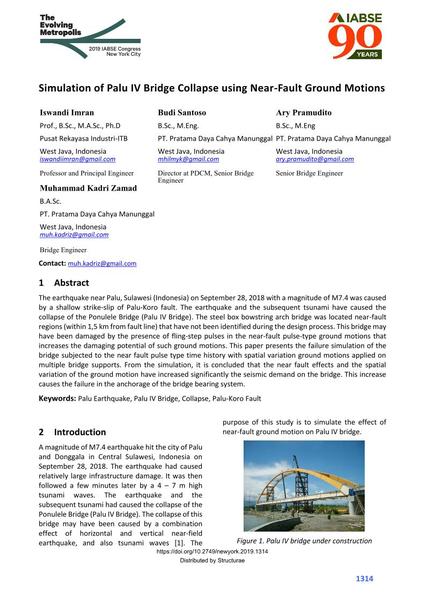Simulation of Palu IV Bridge Collapse using Near-Fault Ground Motions

|
|
|||||||||||
Détails bibliographiques
| Auteur(s): |
Iswandi Imran
(Pusat Rekayasa Industri-ITB)
Budi Santoso (PT. Pratama Daya Cahya Manunggal) Ary Pramudito (PT. Pratama Daya Cahya Manunggal) Muhammad Kadri Zamad (PT. Pratama Daya Cahya Manunggal) |
||||
|---|---|---|---|---|---|
| Médium: | papier de conférence | ||||
| Langue(s): | anglais | ||||
| Conférence: | IABSE Congress: The Evolving Metropolis, New York, NY, USA, 4-6 September 2019 | ||||
| Publié dans: | The Evolving Metropolis | ||||
|
|||||
| Page(s): | 1314-1320 | ||||
| Nombre total de pages (du PDF): | 7 | ||||
| DOI: | 10.2749/newyork.2019.1314 | ||||
| Abstrait: |
The earthquake near Palu, Sulawesi (Indonesia) on September 28, 2018 with a magnitude of M7.4 was caused by a shallow strike-slip of Palu-Koro fault. The earthquake and the subsequent tsunami have caused the collapse of the Ponulele Bridge (Palu IV Bridge). The steel box bowstring arch bridge was located near-fault regions (within 1,5 km from fault line) that have not been identified during the design process. This bridge may have been damaged by the presence of fling-step pulses in the near-fault pulse-type ground motions that increases the damaging potential of such ground motions. This paper presents the failure simulation of the bridge subjected to the near fault pulse type time history with spatial variation ground motions applied on multiple bridge supports. From the simulation, it is concluded that the near fault effects and the spatial variation of the ground motion have increased significantly the seismic demand on the bridge. This increase causes the failure in the anchorage of the bridge bearing system. |
||||
